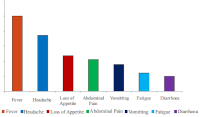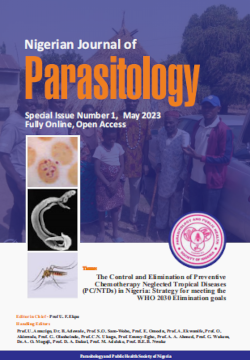Molecular Characterisation of Plasmodium species in Children Attending 9 Brigade Hospitals, Ikeja Military Cantonment, Lagos State, Nigeria
DOI:
https://doi.org/10.4314/njpar.v46i2.8Keywords:
PCR, Plasmodium species, Asymptomatic, Symptomatic, MalariaAbstract
Nigeria has remained the most burdened malaria-endemic nation in the world despite the vast resources committed. This study was conducted to characterise Plasmodium species infecting children attending the Ikeja Military Cantonment Hospital, Ikeja, Lagos State, Nigeria. A total of 450 (350 symptomatic and 100 asymptomatic) blood samples from children aged 0 to 15 years, comprising 219 females and 231 males, were analysed by microscopy, Rapid Diagnostic Test (RDT), and Polymerase Chain Reaction (PCR). The overall prevalence rates of malaria infection by microscopy, RDTs, and PCR were 18.9%, 17.1%, and 20.4%, respectively. The prevalence of Plasmodium species infections by microscopy, RDTs, and PCR was 19.7%, 18.3%, and 20.3% in symptomatic children and 16.0%, 13.0%, and 21.0% in asymptomatic children, respectively. Among the positive subjects using RDT, microscopy, and PCR, 10.0%, 10.7%, and 10.7% were male, while 7.1%, 8.2%, and 9.7% were female, respectively. Regarding age, the prevalence of malaria was 6.7%, 4.4%, and 7.8% using microscopy, RDT was 5.3%, 4.9%, and 6.9%, while PCR was 7.1%, 5.1%, and 8.2% at 0–5, 6–10, and 11–15 years, respectively. Furthermore, 24.7%, 41.2%, and 34.1% of the subjects had parasite density counts of less than 5000/µl, 5000–10000/µl and greater than 10,000/µL, respectively. Using PCR, in symptomatic subjects, 13.7% were infected with P. falciparum, while 2.0% were infected with P. malariae, while in asymptomatic subjects, 4.4% and 0.2% were infected with P. falciparum and P. malariae, respectively. Therefore, continuous systematic school-based interventions are required.
References
Abdulraheem, M. A., Ernest, M., Ugwuanyi, I., Abkallo, H. M., Nishikawa, S., Adeleke, M., Orimadegun, A. E., & Culleton, R. (2022). High prevalence of Plasmodium malariae and Plasmodium ovale in co-infections with Plasmodium falciparum in asymptomatic malaria parasite carriers in southwestern Nigeria. International journal for parasitology, 52(1), 23–33. https://doi.org/10.1016/j.ijpara.2021.06.003
Tang, J., Templeton, T. J., Cao, J., & Culleton, R. (2020). The Consequences of Mixed-Species Malaria Parasite CoInfections in Mice and Mosquitoes for Disease Severity, Parasite Fitness, and Transmission Success. Frontiers in Immunology, 10, 3072. https://doi.org/10.3389/fimmu.2019.03072
World Health Organisation (2020). Guidelines for the treatment of malaria, 2nd edition. Geneva: World Health Organisation. Available at: https://doi.org/10.1071/EC12504. Accessed 3rd December 2023.
World Health Organisation (2021). World Malaria Report 2019. Switzerland: World Health Organisation. Available at: https//:www.who.org/world-malaria-report-2021.
Laishram, D. D., Sutton, P. L., Nanda, N., Sharma, V. L., Sobti, R. C., Carlton, J. M., & Joshi, H. (2012). The complexities of malaria disease manifestations with a focus on asymptomatic malaria. Malaria Journal, 11, 29. https://doi.org/10.1186/1475-2875-11-29
Nundu, S. S., Culleton, R., Simpson, S. V., Arima, H., Muyembe, J. J., Mita, T., Ahuka, S., & Yamamoto, T. (2021). Malaria parasite species composition of Plasmodium infections among asymptomatic and symptomatic school-age children in rural and urban areas of Kinshasa, Democratic Republic of Congo. Malaria Journal, 20(1), 389. https://doi.org/10.1186/s12936-021-03919-4
Ibidapo C. A. (2005). Perception of causes of malaria and treatment-seeking behaviour of nursing mothers in a rural community. The Australian journal of rural health, 13(4), 214–218. https://doi.org/10.1111/j.1440-1584.2005.00704.x
Opara, K. N., Atting, I. A., Ukpong, I. G., Nwabueze, A. A. & Inokon, I. I. (2021). Susceptibility of genetic indices to falciparum malaria in infants and young children in southern Nigeria. Pakistan Journal of Biological Sciences, 9(3), 452-456 DOI: 10.3923/pjbs.2006.452.456
Ikeh, E., Peletiri, I. C. & Angyo, I. A. (2022). The prevalence and Intensity of malaria parasites in children at Jos University Teaching Hospital, Nigeria. Highland Medical Research Journal, 21(1), 9-10 DOI:10.4314/hmrj.v1i1.33790
Oboh, M. A., Badiane, A. S., Ntadom, G., Ndiaye, Y. D., Diongue, K., Diallo, M. A., & Ndiaye, D. (2018). Molecular identification of Plasmodium species responsible for malaria reveals Plasmodium vivax isolates in Duffy negative individuals from southwestern Nigeria. Malaria Journal, 17(1), 439. https://doi.org/10.1186/s12936-018-2588-7
World Health Organisation(2018). List of known commercially available antigen-detecting malaria RDTs and other methods of diagnosing malaria. Accessed December 2nd, 2023. Available at: http://www.wpro.who.int/sites/rdt
World Health Organisation (2022). Malaria by Numbers: Global and Regional Burden. Available at: https://www.who.int/campaigns/world-malaria day/2023/background.
Conrad, M. D., & Rosenthal, P. J. (2019). Antimalarial drug resistance in Africa: the calm before the storm. The Lancet. Infectious Diseases, 19(10), e338–e351. https://doi.org/10.1016/S1473-3099(19)30261-0
Mathieu, L. C., Cox, H., Early, A. M., Mok, S., Lazrek, Y., Paquet, J. C., Ade, M. P., Lucchi, N. W., Grant, Q., Udhayakumar, V., Alexandre, J. S., Demar, M., Ringwald, P., Neafsey, D. E., Fidock, D. A., & Musset, L. (2020). Local emergence in Amazonia of Plasmodium falciparum k13 C580Y mutants associated with in vitro artemisinin resistance. eLife, 9, e51015. https://doi.org/10.7554/eLife.51015
Uwimana, A., Legrand, E., Stokes, B. H., Ndikumana, J. M., Warsame, M., Umulisa, N., Ngamije, D., Munyaneza, T., Mazarati, J. B., Munguti, K., Campagne, P., Criscuolo, A., Ariey, F., Murindahabi, M., Ringwald, P., Fidock, D. A., Mbituyumuremyi, A., & Menard, D. (2020). Emergence and clonal expansion of in vitro artemisinin-resistant Plasmodium falciparum kelch13 R561H mutant parasites in Rwanda. Nature medicine, 26(10),
–1608. https://doi.org/10.1038/s41591-020-1005-2
Anton, L., Cobb, D. W., & Ho, C. M. (2022). Structural parasitology of the malaria parasite Plasmodium falciparum. Trends in biochemical
Sato, S. (2021). Plasmodium - a brief introduction to the parasites causing human malaria and their basic biology. Journal of physiological anthropology, 40(1), 1. https://doi.org/10.1186/s40101-020-00251-9
Daniel, W. W., & Cross, C. L. (1999). Determination of sample size for estimating proportions. Biostatistics: A Foundation for Analysis in the Health Sciences, 8, 189-190 https://www.scirp.org/reference/referencespapers?referenceid=3583981
Umaru, M. L. & Uyaiabasi, G. N. (2021). Prevalence of malaria in patients attending the General Hospital, Makarfi, Markarfi, Kaduna State, North-Western Nigeria. American Journal of Infectious Disease in Microbiology, 9(3), 11-15. DOI: 10.12691/ajidm-3-1-1
Rodulfo, H., De Donato, M., Mora, R., González, L., & Contreras, C. E. (2007). Comparison of the diagnosis of malaria by microscopy, immunochromatography and PCR in endemic areas of Venezuela. Brazilian Journal of Medical and Biological Research = Revista brasileira de pesquisas medicas e biologicas, 40(4), 535–543. https://doi.org/10.1590/s0100-879x2007000400012
Parija S. C. (2010). PCR for diagnosis of malaria. The Indian Journal of Medical Rresearch, 132, 9–10.
Salako, L. A., Ajayi, F. O., Sowunmi, A., & Walker, O. (1990). Malaria in Nigeria: a revisit. Annals of tropical medicine and parasitology, 84(5), 435–445. https://doi.org/10.1080/00034983.1990.11812493
Aina, O. O., Agomo, C. O., Olukosi, Y. A., Okoh, H. I., Iwalokun, B. A., Egbuna, K. N., Orok, A. B., Ajibaye, O., Enya, V. N., Aindele, S. K., Akindele, M. O. & Agomo, P. U. (2021). Malariometric survey of Ibeshe community in Ikorodu, Lagos State: dry season. Malaria Research Treatment, 23(3), 456-461.
Igbeneghu, C. & Odaibo, A. B. (2022). Plasmodium species among the inhabitants of Iwo community, southwestern Nigeria.American Eurasian Journal of Science Research, 17(2), 118–122. DOI: 10.5829/idosi.aejsr.2012.7.3.6552
Doolan, D. L., Dobaño, C., & Baird, J. K. (2009). Acquired immunity to malaria. Clinical Microbiology Reviews, 22(1), 13–36. https://doi.org/10.1128/CMR.00025-08
Coalson, J. E., Walldorf, J. A., Cohee, L. M., Ismail, M. D., Mathanga, D., Cordy, R. J., Marti, M., Taylor, T. E., Seydel, K. B., Laufer, M. K., & Wilson, M. L. (2016). High prevalence of Plasmodium falciparum gametocyte infections in school-age children using molecular detection: patterns and predictors of risk from a cross-sectional study in southern Malawi. Malaria Journal, 15(1), 527. https://doi.org/10.1186/s12936-016-1587-9
Sattabongkot, J., Suansomjit, C., Nguitragool, W., Sirichaisinthop, J., Warit, S., Tiensuwan, M., & Buates, S. (2018). Prevalence of asymptomatic Plasmodium infections with sub-microscopic parasite densities in the northwestern border of Thailand: a potential threat to malaria elimination. Malaria Journal, 17(1), 329. https://doi.org/10.1186/s12936-018-2476-1
Mahittikorn, A., Masangkay, F. R., Kotepui, K. U., Milanez, G. J., & Kotepui, M. (2021). Comparison of Plasmodium ovale curtisi and Plasmodium ovale wallikeri infections by a meta-analysis approach. Scientific Reports, 11(1), 6409. https://doi.org/10.1038/s41598-021-85398-w
Nwaneli, E. I., Eguonu, I., Ebenebe, J. C., Osuorah, C. D. I., Ofiaeli, O. C., & Nri-Ezedi, C. A. (2020). Malaria prevalence and its sociodemographic determinants in febrile children - a hospital-based study in a developing community in South-East Nigeria. Journal of Preventive Medicine and Hygiene, 61(2), E173–E180. https://doi.org/10.15167/2421-4248/jpmh2020.61.2.1350
Mbanugo, J. I. & Ejim, D. O. (2020). Plasmodium Infections in Children Aged 0-5 yrs in Awka Metropolis, Anambra State, Nigeria. Nigerian Journal of Parasitology, 27(2), 55-59.
Nwaorgu, O. C. & Orajaka, B. N. (2021). Prevalence of Malaria among Children 1 – 10 Years Old in Communities in Awka North Local Government Area, Anambra State, Southeast Nigeria. International Multidisciplinary Journal, 15(5), 264-281 DOI:10.4314/afrrev.v5i5.21
Ezeudu, C. E., Ebenebe, J. C., Ugochukwu, E. F., Chukwuka, J. O., Amilo, G. I. & Okorie, O. I. (2022). Performance of a Histidine rich protein-2 rapid diagnostic test (RDT) against the standard microscopy in the diagnosis of malaria parasitemia among febrile under-five children at Nnewi. Nigerian Journal of Paediatrics, 49(3), 259-263. DOI:10.4314/njp.v42i1.13
Dinko, B., Oguike, M. C., Larbi, J. A., Bousema, T., & Sutherland, C. J. (2013). Persistent detection of Plasmodium falciparum, P. malariae, P. ovale curtisi and P. ovale wallikeri after ACT treatment of asymptomatic Ghanaian schoolchildren. International Journal for Parasitology Drugs and Drug Resistance, 3, 45–50. https://doi.org/10.1016/j.ijpddr.2013.01.001
Greenwood, B. M., Bradley, A. K., Greenwood, A. M., Byass, P., Jammeh, K., Marsh, K., Tulloch, S., Oldfield, F. S., & Hayes, R. (1987). Mortality and morbidity from malaria among children in a rural area of The Gambia, West Africa. Transactions of the Royal Society of Tropical Medicine and Hygiene, 81(3), 478–486. https://doi.org/10.1016/0035-9203(87)90170-2
Hedelius, R., Fletcher, J. J., Glass, W. F., 2nd, Susanti, A. I., & Maguire, J. D. (2011). Nephrotic syndrome and unrecognized Plasmodium malariae infection in a US Navy sailor 14 years after departing Nigeria. Journal of Travel Medicine, 18(4), 288–291. https://doi.org/10.1111/j.1708-8305.2011.00526.x
Llinás, M., Bozdech, Z., Wong, E. D., Adai, A. T., & DeRisi, J. L. (2006). Comparative whole genome transcriptome analysis of three Plasmodium falciparum strains. Nucleic Acids Rresearch, 34(4), 1166–1173. https://doi.org/10.1093/nar/gkj517

Downloads
Published
How to Cite
Issue
Section
License
Copyright (c) 2025 Nigerian Journal of Parasitology

This work is licensed under a Creative Commons Attribution-NonCommercial-NoDerivatives 4.0 International License.




